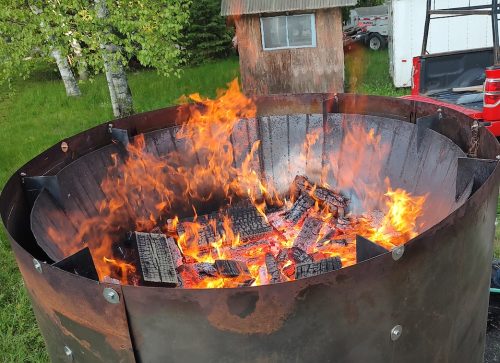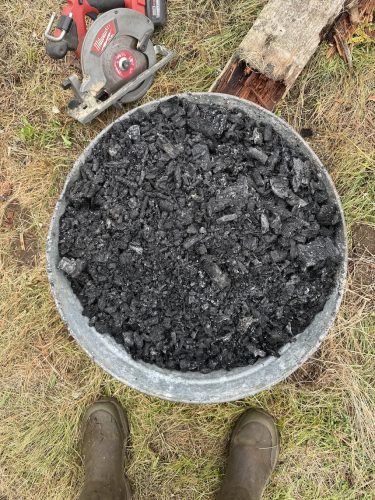By Nicole Draina, Climate & Energy Communications Coordinator for ANCA and the North Country Clean Energy Hub
On a Saturday in late spring, my mother would get up with the birds and make her way to the garden. I’d trail after her, squishing the wet blades of grass between my bare toes. Our family garden was simple – a large rectangle on the edge of the property enclosed with a white fence. The slats of the fence were just wide enough for the rabbits to sneak through and nibble the tomatoes.
As a child, I was mesmerized with the trellis archway that beckoned me to enter and walk under the deep purple morning glories who had just awoken at dawn. I could sit down between the green beans climbing the fence and the row of Romas – hidden in a magical world. One of abundance.
My mother taught me the secrets of the magical world, ones that were passed down through generations. Like wrapping newspaper around roots to prevent bugs from eating your plants or placing a border of marigolds to deter the rabbits (who were never deterred). And by midsummer, we’d have a bounty. I would come to know the correct pitch that signals a successfully canned jar of tomatoes – tapping the spoon on the metal mason jar lid. My mother’s canning skills would supply our family through the winter until the next spring.
As the summers passed, the paint began to peel on the fence. Our crops that once thrived struggled to be vibrant. Too hot. Too many storms. Too much water. My cousins, on a small farm next door, used to harvest strawberries for their stand – but each year their crop failed. Eventually, they stopped growing berries and lost that supplemental income, something which helps rural families survive in our region.
Strategy after strategy. We tried raised garden beds with fresh soil, new fertilizers, and different strands of plants. Nothing seemed to sustain the health of the soil. But what if the solution wasn’t some newfound strategy? What if it was something of the past? Some generational wisdom?
There’s a deep well of value in generational knowledge, especially the wisdom passed down through Indigenous traditions. These practices often carry insights about the land — lessons some are only beginning to rediscover. Biochar — an Indigenous technique that transforms organic material into a soil enhancer — is just one example. Today, we can adapt this practice with modern, yet sustainable techniques, bridging centuries of wisdom to face modern environmental challenges.
Environmental Benefits

A specialized kiln called a Kon Tiki used to generate biochar on Bonaparte Bare Bones Farm
Biochar (short for biological charcoal) has been part of Indigenous “agricultural practices from over 2,500 years ago” and has been an addition to soil for improved “fertility and crop yields” (Fergerson and Sievert, 2024). And you might even remember your eighth grade history teacher talking about “black earth” or the European name “Terra Preta” when describing the agricultural practices of Mesoamerica. More recently though, it has been brought into the spotlight due to corporations selling biochar commercially. Unfortunately, history tells us that commercial use and exploitation often lead to harm on Indigenous communities — the original stewards of the land.
Known to Kuikuro farmers along the Xingu River in Brazil as eeqepe, biochar is a highly permanent, solid form of carbon (Mangan, 2024). It’s kind of in the realm of composting, kind of looks like charcoal, but instead it is cooked under specific conditions. Biochar is created by heating biomass like wood, crop residues or even animal manure “between 400-800°C in an oxygen-limited environment through a process called pyrolysis” (Fergerson and Sievert, 2024). The process gives us three products: gas, oil, and a solid known as biochar. What makes biochar truly special is what happens when it’s added to the soil. It helps the soil hold onto nutrients and encourages microbes to thrive, and in turn supports a more abundant, nutritious, and some say sweeter harvest. For maximum benefits, it’s suggested that biochar be charged with nutrients and additional microbes by mixing in organically rich materials, like compost (Mangan, 2024).
With recent studies, our Eurocentric framework is adjusting to understand the remarkable depth of Indigenous Knowledge surrounding biochar. At ANCA’s recent Bike the Barns event, we heard from Essex County farmers about the challenges they faced in sustaining their crops during the recent drought. One promising solution is biochar, whose unique microstructure increases soil porosity, helping plants access water more efficiently and retain moisture during dry spells (Mangan, 2024). Conversely, it also helps keep important nutrients in place during heavy rainstorms. As climate change continues to cause greater seasonal variability, it is essential to expand education and Indigenous Knowledge about the benefits of biochar so our region can adapt and thrive.
Keeley Jock, who is Kanien’kehá:ka (Mohawk) of the Haudenosaunee Confederacy, asserts that using Indigenous Knowledge “cultivated over thousands of years can save this planet.” Keeley, now the Indigenous Partnerships Program Associate for the Nature Conservancy based in its Adirondack office, recently served as Climate Justice Fellow for ANCA. She wrote that Indigenous Knowledge “can and should be used in answering today’s questions” (2024).
Biochar offers a path forward to help not only the soil in our region but also our planet. The extremely stable atomic structure “sequesters the majority of its carbon content for thousands of years” (Fergerson and Sievert, 2024). So, instead of letting it escape into the atmosphere, it’s kept locked away. But biochar doesn’t just trap carbon – it also acts like a sponge, soaking up harmful pollutants in soil and water. This means it can reduce heavy metals and contaminants, keeping them from leaking into groundwater that could be entering our food systems (Breneman, 2023). In short, biochar is a climate solution, natural purifier, and soil enhancer working quietly to make our environment safer and healthier.
 Challenges
Challenges
Keep in mind there are certain challenges that should be considered when integrating biochar into farming systems. To produce high-quality biochar, there needs to be complete control over the pyrolysis conditions to “maximize carbon retention and minimize emissions” (Fergerson and Sievert, 2024). Also, it would be counterproductive if biochar became commercialized, sourcing materials and depleting the land, when instead we should look to recycling waste and making it a circular farming system (Lima et al., 2024). This circular system would prevent unwanted transportation emissions and costs, while also freeing up acres of land that could be utilized for sustainable farming needs.
Although there are challenges with biochar, these challenges should not be seen as a greater obstacle than those we currently face from increased storm intensity and changing climate impacts. Biochar can foster resiliency in our communities and “stands out as a testament to the enduring relevance of Indigenous practices in shaping sustainable solutions for the future” (Fergerson and Sievert, 2024).
Weaving Knowledge
If you sit quietly in our family garden, you’ll hear a variety of birds gathered in the hardwoods. The chickadees, finches, and warblers – all in one tree, their songs converging. As we acknowledge Indigenous Peoples Month, we have the opportunity to recognize how essential Indigenous Traditional Ecological Knowledge is to our current climate crisis. There is an opportunity to partner with Indigenous communities for reciprocal learning – a weaving together of systems.
I often think about the types of knowledge passed down through generations. Still to this day, I can hear the rhythm of my mother’s messages in that magical garden telling me to mix my radish and carrot seeds, wrap the roots in newspaper, and don’t plant the corn near the cattle corn.
Biochar reminds us that generational wisdom isn’t just history – it offers an opportunity to heal the earth through practices and partnerships that elevate Indigenous wisdom and inspire tomorrow’s environmental solutions.
*ANCA is currently partnering with Bonaparte Bare Bones Farm from Akwesasne to test on the farm creation and application of biochar. Multiple workshops will be held across the North Country on biochar for reciprocal learning opportunities. Please contact [email protected] to learn more.
References 
Breneman, J. (2023, February 7). Ancient biochar method revamped for modern challenges. Natural Resources Research Institute, University of Minnesota. https://nrri.umn.edu/news/balsam-fir-biochar
Fergerson, M., and Sievert, L. (2024, July 9). Rediscovering the ancient wisdom of biochar. Berkeley Energy & Resources Collaborative. https://berc.berkeley.edu/news/rediscovering-ancient-wisdom-biochar
Keeley, Jock. (2023, March 15). Reviving wetlands with Indigenous knowledge with Keeley Jock. TEDxTupper Lake. YouTube. https://www.youtube.com/watch?v=00-C1hdYYB0
Lima, I., Grumke, K., and Kelly, M. (2024, May 17). Podcast: Indigenous people have been using biochar to fertilize soil for centuries. Could renewing this practice be a lasting solution for carbon sequestration? NPR. https://geneticliteracyproject.org/2024/05/17/podcast-indigenous-people-have-been-using-biochar-to-fertilize-soil-for-centuries-could-renewing-this-practice-be-a-lasting-solution-for-carbon-sequestration/
Mangan, A. (2024, July 19). Biochar: An ancient method of healing modern soils. Bioneers. https://bioneers.org/biochar-an-ancient-method-of-healing-modern-soils/
